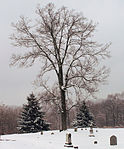Ohio's 1st congressional district
1813 establishments in OhioCongressional districts of OhioConstituencies established in 1813Data missing from February 2020Use mdy dates from May 2021

Ohio's 1st congressional district is represented by Republican Steve Chabot. This district includes the western four-fifths of Cincinnati, and borders both Kentucky and Indiana. This district was once represented by President William Henry Harrison. Since redistricting in 2010, the district is widely seen by Democrats as heavily gerrymandered by state Republicans to protect the incumbent, Steve Chabot. The new district includes all of Warren County, a much more heavily Republican area. Previous iterations of the district did not include Warren County.
Excerpt from the Wikipedia article Ohio's 1st congressional district (License: CC BY-SA 3.0, Authors, Images).Ohio's 1st congressional district
I 74;US 52, Cincinnati Northside
Geographical coordinates (GPS) Address Website Nearby Places Show on map
Geographical coordinates (GPS)
| Latitude | Longitude |
|---|---|
| N 39.166666666667 ° | E -84.566666666667 ° |
Address
Mount Airy Forest
I 74;US 52
45223 Cincinnati, Northside
Ohio, United States
Open on Google Maps









